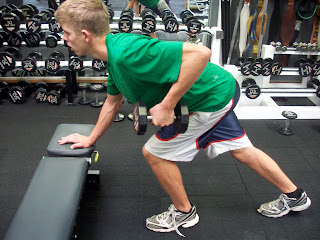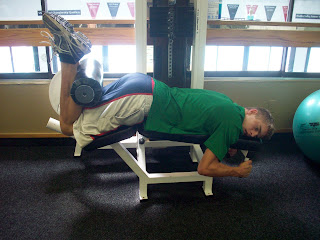This entry is designed to give you simple, easy-to-do moves in the gym. Many of them you can do outside of the gym, with a set of dumbbells.
I've organized it around 9 major muscle groups:
Upper Body:
1. Shoulders (deltoids)
2. Chest
3. Biceps
4. Triceps
5. Back
Lower Body:
6. Abdominals
7. Quadriceps (front thigh)
8. Hamstrings (back thigh)
9. Calves
Note: In order to see results, strength training involves a complex relationship between the size of the weight and the number of reps. It also involves eating a well-rounded diet of whole natural foods and the proper amount of protein. Every individual is different in terms of current strength and goals, and therefore, I want to direct your attention to an additional resource:
This book allows each individual to design a program that works for THEM. If explains strength-training in a very straight forward way. If you are looking to lose weight, build muscle, and feel great, this book has all the information you need. I have a copy if you would like to borrow it!
Back to the gym. . .
With the help of my brother Sam (age 15, green shirt) and his friend Kirill (age 18, blue shirt), we got some photos at a recent trip to the gym in Boulder. Each move targets one or two of the major muscle groups, and should be easy to understand from the pictures.
Follow these moves for a full-body strength-training workout. More info at the end!
1. Lunge + Bicep Curl (working legs and arms)
 |
| Curl up as you lunge down |
3. Squat with Bar (working back and lower body)
4. Tricep Push-downs
5. Side Raises (shoulders)
 |
| Keep your arms bent as you raise them to shoulder level |
7. One-Arm Dumbbell Row (back)
8. Squat + Dumbbell Press (lower body and shoulders)
9. Angled Calf Raises
10. Lying Leg Curls (hamstrings)
11. Crunches
 |
| Keep your eyes fixed on the ceiling and raise your shoulder blades off the floor |
 |
| Hold for one minute! Feel the burn. |
What size weight should I start with, and how many reps should I do?
That depends on your current level of strength. Muscle builds after it is "ripped". The repair process builds the muscles, makes you stronger, and decreases fat. Pick up a weight that feels easy to do at first and try 12 reps. If you are not fatigued at the end of 12 reps, try a heavier weight.
Body-For-Life would suggest the following:
Increase weight and decrease reps, then at the end of a set, increase the weight and the reps until you cannot life it another time. The goal is to max out!
12 bicep curls with 8 lbs (50% intensity), rest a min,
10 curls with 10 lbs (60% intensity), rest a min
8 reps with 12 lbs (70% intensity), rest a min
6 reps with 15 lbs (80%), rest a min
12 reps with 12 lbs NO REST
10 reps with 12 lbs (or something along those guidelines).
Again, I cannot emphasize enough that every individual is SO DIFFERENT in what they need. Therefore, I would check out the Body for Life book, or another resource that looks appealing to you. When I come across additional strength-training resources, I will write about them here.
What other questions do you have? This is such a huge topic and there is a lot of information to sort through. Let me know if something comes up for you, and I can try and answer it here.
K, now stop reading and go work out!
Love,
Dana



















































